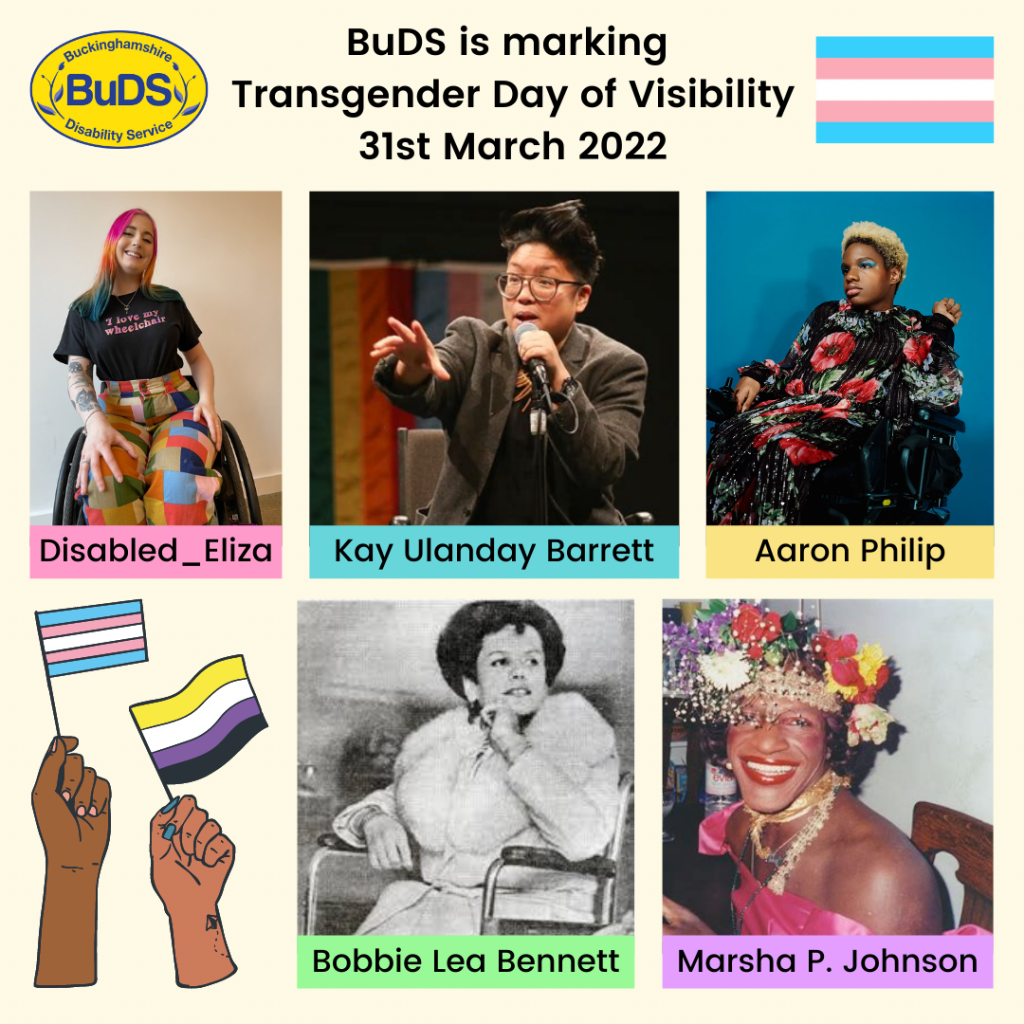
Transgender Day of Visibility 2022
One of our volunteers has written about five disabled transgender and non-binary people for this year’s Transgender Day of Visibility.
They talk about what it’s like trying to find role models as a non-binary and disabled person, especially on days like this.
The Overlap of Disabled and Transgender Communities
As a queer, nonbinary, disabled, neurodivergent person, both my gender and my disabilities affect the way I interact with the world. I am not alone in this, but prominent role models for disabled transgender and non-binary people are sadly few and far between. Today is Trans Day of Visibility and I want to take a moment to highlight five transgender and non-binary disabled people.
Before I start, I want to talk about disability in the transgender community.
In the 2021 report by the trans-led UK organisation, TransActual, 700 trans people were surveyed. Just under half of those who responded were disabled, and over half were neurodivergent. In a separate report, it was estimated in the US that 2 in 5 transgender adults also have a disability.
A 2019 report by the UK government showed higher prevalence of mental health problems, with 24% of all people accessing mental health services. However, this increased to 30% for trans women, 40% for trans men and 37% for non-binary people.
Clearly neurodiversity, disability, and mental health conditions are common in transgender people. Yet, when you look to the media, we have very few role models. As promised, here are five people I want to talk about.
Marsha P. Johnson
The first is Marsha P. Johnson. Probably one of the most well-known LGBT rights activists, she was prominent in the Stonewall riots in 1969 that had a large impact on the gay rights movement. She helped create STAR (Street Transvestite Action Revolutionaries) which provided shelter to young homeless transgender people and called for the end of conversion therapies, amongst other things. Marsha P. Johnson had both physical and mental disabilities and was subjected to medical treatments without her consent.
Bobbie Lea Bennett
The next disabled transgender person I want to talk about is Bobbie Lea Bennett. She was a wheelchair user who fought for the USA Medicare to include sex reassignment surgery. In 1978, she had been told her gender affirmation surgery would be covered, but her payment was denied. She drove across America to the office of the Medicare director and refused to leave until she’d met them. Her work led to Medicare including sex reassignment, as long as the individual had “at least one year’s experience living as a member of the opposite sex”.
Aaron Philip
Aaron Philip is a model, also from the US. She has cerebral palsy and is a gender non-conforming trans woman. She’s promoting accessibility, inclusion and diversity in the world of modelling and fashion. Aaron wants people to have the jobs they want, regardless of race, gender or disability, and at age 21 she has been called a trailblazer for diversity in the fashion industry.
Kay Ulanday Barrett
Kay Ulanday Barrett is a disabled transgender poet. They have led workshops at universities and museums and have worked with many activist groups working to help trans people of colour. They explore intersectionality in their poetry and workshops, focussing on social justice, disability and chronic illness.
Eliza
The last person I want to highlight is Eliza, known as Disabled_Eliza on social media. They are a UK-based disability activist who uses they/them pronouns. Eliza posts about ableism, hidden conditions and breaking the stigma of disability aids. They also make short videos explaining the ableist history of words and post about disability and lgbt+ positivity.
Closing Thoughts
It was more difficult than it should have been to find these people. We’re already seeing an increase in queer disabled role models, so I can only hope that as time goes on it will be easier for disabled transgender people to find role models to look up to. Having role models and a community is incredibly important.
If you would like support, you can email us at buds-support@buds.org.uk.
Stats Sources:
TransActual report: https://www.transactual.org.uk/trans-lives-21
Disabled LGBT adults: https://www.lgbtmap.org/file/LGBT-People-With-Disabilities.pdf
2019 UK government report: https://www.gov.uk/government/publications/national-lgbt-survey-summary-report/national-lgbt-survey-summary-report
This is a personal blog by a BuDS volunteer/member or staff/supporter. The views expressed are personal and don’t necessarily represent those of BuDS or our Trustees.
